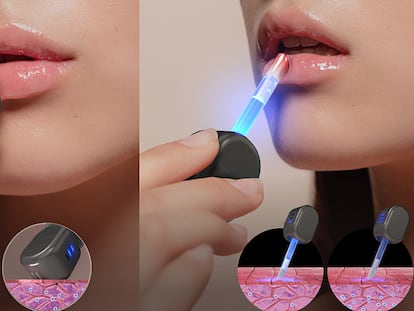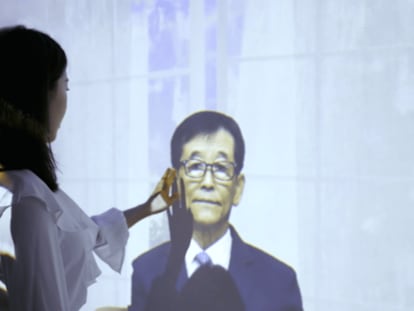Unusual inventions at CES 2024: mood-reading light bulbs to air-purifying plants
Our top 10 at the world’s largest consumer tech expo includes a self-rocking stroller, an AI that designs clothes and a head for avatars

CES 2024 showcased all sorts of amazing inventions: airbags for motorcycles, inflatable farms, performance-enhancing leggings, plant-pet flower pots, palm-sized shavers, speaker-equipped photo frames, and futuristic robots. The world’s largest consumer technology expo held in Las Vegas never fails to astound with new inventions like anti-snoring pillows, smart mirrors, and emotion-detecting devices for babies and pets.
Last year at CES, there were some intriguing devices like interactive masturbators, printers for dyeing hair, and masks for making incognito video calls. One of the coolest inventions this year is a light bulb from Lepro that can use facial recognition to analyze the emotional state of a user and change the lighting to match their mood. The bulb is also equipped with an algorithm that simulates the human auditory system and synchronizes the lights according to the music that is playing to create an immersive audiovisual experience for the user.
French startup Neoplants claims the company has developed a plant that can eliminate indoor air pollution 30 times more effectively than a regular houseplant. “We actually work on the DNA of plants,” said Neoplants’ Alexandre Galbiati. “We design them through bioengineering and insert a gene that allows them to absorb contaminants and turn them into plant matter.” Galbiati says it’s only available in the United States, where plant genome editing is permitted.
Self-rocking stroller
At one of the rooms in Mandalay Bay, one of the hotels hosting CES, a baby stroller rocks gently by itself. Kevin Huang, the CEO of GlüxKind, stands nearby and observes. This Canadian company has developed a stroller that utilizes artificial intelligence to simplify parenting. The aim is to provide parents with an additional set of eyes and hands when they are out and about. “You can easily climb the steep hills of San Francisco or effortlessly go downhill with groceries in hand,” said Huang. “The cart not only moves but also stops and brakes automatically, making your life worry-free. The stroller at home comes in handy too. It can rock the baby while you read a book, sip coffee, or simply take a break.”
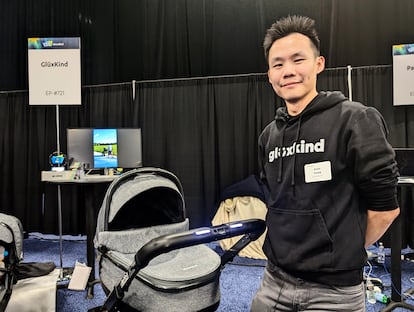
Robot to help you walk
Wirobotics defines their wearable robot as an easy and effective way to turn walking into exercise. The robot consists of a belt attached to the upper legs with metal struts. One mode assists with walking by lifting and pushing the legs, while the other provides resistance to strengthen the legs. While primarily designed for older people and those with Parkinson’s or sarcopenia, it also caters to the young. “It can actually help them adopt a better posture while walking,” said Ji Young Kim from Wirobotics.
Phone case that turns an iPhone into a Blackberry
Physical keyboards on cell phones are a thing of the past, gradually replaced by larger touchscreens. However, Clicks Technology has developed an iPhone case that caters to nostalgic fans of the iconic Blackberry. The company that created it boasts former employees from Blackberry, Apple and Google among its ranks. At first glance, this case may have two downsides: its steep price of $137 (€125) and its bulky size, which makes it feel more large a wide TV remote than a sleek mobile phone.
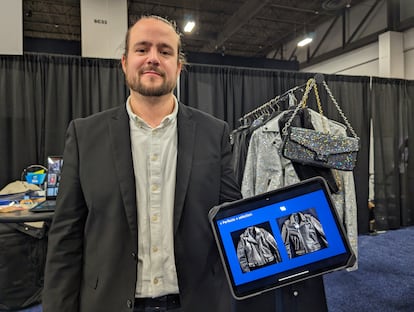
AI that designs clothing
Generative AI goes far beyond ChatGPT. “Everything you see here has been designed by AI,” said Florent Michel, pointing to handbags, trousers and leather jackets studded with diamonds. Michel works for Imki, a startup that applies AI to clothing design in collaboration with fashion houses. Previously, designers used to sketch their ideas by hand and then use programs like Photoshop to render their final drawings. Now, all they need to do is write text descriptions of their design concepts and view the results. How do these AI-designed clothes differ from those created by humans? “They don’t. That’s the point,” said Michel.
Avatar head
Some inventions at this year’s CES look like they came straight out of the Black Mirror TV series. Last year, avatars for deceased relatives attracted some interest. Now, one of the most surreal gadgets is a head for avatars – the WeHead. It’s a display that allows you to feel the presence of a virtual human or a digital clone of a person in the physical world. “As humans enter the virtual worlds of the metaverse via their digital avatars,’ said the inventors, “WeHead offers digital human developers the possibility to bring their AI agents to the real world via a physical device.”
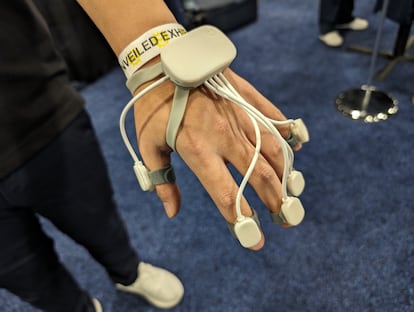
Device to touch virtual reality
Palmplug is a device that monitors hand movements and uses haptic technology to provide users with a sense of touch in video games. “Say you’re looking at a virtual reality image of a car. With PalmPlug, when you reach out and touch it, you can actually feel the vibrations,” said Palmplug’s Kevin Shi. “Or you can put your hand in [a VR image of] flowing water and feel it.” The device can also aid in rehabilitation, such as post-stroke recovery. “You can turn the exercises into a game so you don’t get bored too quickly. Plus, you can even share the data from the glove with your doctor.”
AI that translates medications
“If you try to use Google Translate to find the French equivalent of Tylenol (paracetamol), it’s not going to give you the answer,” said Cristopher Burrow, head of Humetrix’s medical informatics and data analytics group. This company has created SOSQR Global, an AI-powered platform that translates medical terms and medications into over 20 languages in 150+ countries. “When you’re traveling and a specialist needs to check your medical history, or if the medication you use has a completely different name in another place, it can be very useful.”
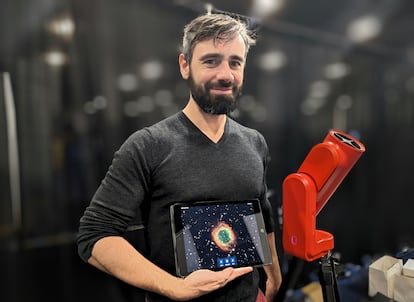
Telescope for accessible astronomy
Using a telescope for the first time can be frustrating, says Laurent Marfisi of Unistellar. “The first issue is that you might not see much with a regular telescope. And the second thing is that using these telescopes can be quite tricky,” he said. His company offers a solution – a smart telescope for accessible astronomy. It identifies celestial objects, captures photos, and sends them to your phone. It can even send notifications. “For instance, it’ll let you know that today is a great day to catch a glimpse of Jupiter in your neighborhood,” said Unistellar’s Maggie Zaboura.
Sign up for our weekly newsletter to get more English-language news coverage from EL PAÍS USA Edition
Tu suscripción se está usando en otro dispositivo
¿Quieres añadir otro usuario a tu suscripción?
Si continúas leyendo en este dispositivo, no se podrá leer en el otro.
FlechaTu suscripción se está usando en otro dispositivo y solo puedes acceder a EL PAÍS desde un dispositivo a la vez.
Si quieres compartir tu cuenta, cambia tu suscripción a la modalidad Premium, así podrás añadir otro usuario. Cada uno accederá con su propia cuenta de email, lo que os permitirá personalizar vuestra experiencia en EL PAÍS.
¿Tienes una suscripción de empresa? Accede aquí para contratar más cuentas.
En el caso de no saber quién está usando tu cuenta, te recomendamos cambiar tu contraseña aquí.
Si decides continuar compartiendo tu cuenta, este mensaje se mostrará en tu dispositivo y en el de la otra persona que está usando tu cuenta de forma indefinida, afectando a tu experiencia de lectura. Puedes consultar aquí los términos y condiciones de la suscripción digital.
More information
Archived In
Últimas noticias
Most viewed
- Reinhard Genzel, Nobel laureate in physics: ‘One-minute videos will never give you the truth’
- Pablo Escobar’s hippos: A serious environmental problem, 40 years on
- Charles Dubouloz, mountaineering star, retires at 36 with a farewell tour inspired by Walter Bonatti
- Why we lost the habit of sleeping in two segments and how that changed our sense of time
- The Florida Keys tourist paradise is besieged by immigration agents: ‘We’ve never seen anything like this’

